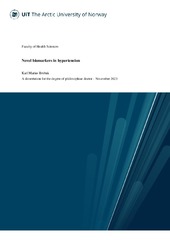Novel biomarkers in hypertension
Permanent lenke
https://hdl.handle.net/10037/33114Dato
2024-04-11Type
Doctoral thesisDoktorgradsavhandling
Forfatter
Brobak, Karl MariusSammendrag
Introduction Hypertension and kidney damage are reciprocally related. Current blood and urine tests cannot reliably detect early kidney damage from hypertension, hindering timely prevention. A biomarker that captures kidney damage due to hypertension at an early stage might improve risk stratification and treatment. The primary objective of this project was to investigate how biomarkers of kidney and endothelial dysfunction are related to blood pressure and hypertension. Additionally, we intend to examine whether markers of kidney function mediate the association between sodium and potassium intake and blood pressure.
Design and methods This thesis includes subjects from the sixth and seventh surveys of the Tromsø study, the Renal Iohexol Clearance Survey in Tromsø6 (RENIS-T6), the cardiovascular remodelling in living kidney donors with reduced glomerular filtration rate study (CENS) (identifier: NCT03729557), and the Individualized blood pressure treatment: a multidisciplinary approach to uncontrolled hypertension in order to reduce morbidity and mortality study (IDA) (identifier: NCT03209154). The Regional Committee for Medical and Health Research Ethics approved the studies, and all participants gave written consent.
Results In a middle-aged North European population without specific health conditions, there was a significant cross-sectional association between urinary sodium/potassium-ratio and blood pressure. The association was not mediated through kidney function measures of glomerular and tubular function, suggesting a relationship between a diet with high sodium and low potassium and higher blood pressure regardless of kidney function. Among patients with hypertension being prescribed ≥2 antihypertensive agents, plasma osteopontin discriminated a participant group with uncontrolled hypertension from that of controlled hypertension, after considering established risk factors. In a North-European general population cohort, urine orosmucoid excretion had a stronger cross-sectional association with blood pressure and a stronger association with incident hypertension after seven years than urine albumin excretion.
Conclusion An unhealthy diet with high sodium and low potassium might raise blood pressure, regardless of kidney function. Orosomucoid and osteopontin may be early markers of kidney damage, but further longitudinal analyses are needed to examine if these markers can improve risk stratification of patients.
Har del(er)
Paper 1: Brobak, K.M., Melsom, T., Eriksen, B.O., Høieggen, A., Norvik, J.V. & Solbu, M.D. The association between urinary sodium-potassium ratio, kidney function, and blood pressure in a cohort from the general population. (Manuscript).
Paper 2: Brobak, K.M., Halvorsen, L.V., Aass, H.C.D., Søraas, C.L., Aune, A., Olsen, E., … Solbu, M.D. Novel biomarkers in patients with uncontrolled hypertension with and without kidney damage. (Manuscript).
Paper 3: Brobak, K.M., Andreassen, R.M., Melsom, T., Høieggen, A., Norvik, J.V. & Solbu, M.D. (2022). Associations of urinary orosomucoid, N-acetyl-β-D-glucosaminidase, and albumin with blood pressure and hypertension after 7 years. The Tromsø Study. Blood Pressure, 31(1), 270-283. Also available in Munin at https://hdl.handle.net/10037/26986.
Forlag
UiT The Arctic University of NorwayUiT Norges arktiske universitet
Metadata
Vis full innførselSamlinger
Følgende lisensfil er knyttet til denne innførselen:


 English
English norsk
norsk
